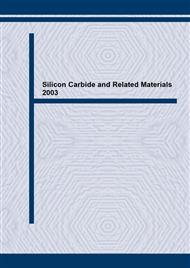[1]
R. Singh, J.A. Cooper, Jr., M.R. Melloch, T.P. Chow, J. W Palmour: IEEE Trans. on Electron Devices Vol. 49, Issue: 4, April 2002, p.665.
DOI: 10.1109/16.992877
Google Scholar
[2]
I. Sankin, J.B. Dufrine, J.N. Merrett and J.B. Casady: Mater. Sci. Forum Vol. 433-436 (2003), p.879.
Google Scholar
[3]
P.G. Neudeck, C. Fazi: IEEE Trans. on Electron Devices Vol. 46, Issue: 3, March 1999, p.485.
Google Scholar
[4]
H.M. McGlothling, D.T. Morizette, J.A. Cooper, Jr. and M.R. Melloch: Digest of the 57th Device Research Conf. (1999), p.42.
Google Scholar
[5]
L.G. Fursin, J.H. Zhao, M. Weiner: Electronic Letters, Vol. 37, No. 17, August 2001 Table 1: Comparison of the results of the current and previous works Previous work This work Wafer # 1 2 3 4 5 Epi thickness/doping, [µm / cm-3] 10/2x10.
Google Scholar
[15]
JTE implant ion Al+ Al+ Al+ Al+ B + JTE implant dose, [cm-2] 2. 2x10.
Google Scholar
[15]
Blocking voltage, [kV] 1. 1 1. 4 1. 8 1. 7 1. 7 Maximum 1D field, [MV/cm] 2. 69 2. 58 2. 63 2. 1 2. 1 Maximum simulated electric field in the bulk, [MV/cm] 2. 9 2. 9 3 3 n/a.
Google Scholar
[2]
[3] [4] [5] [6] 0. E+00 1. E+13 2. E+13 3. E+13 4. E+13 JTE dose, cm^-3 Maximum field in the bulk, MV/cm Wafer 3 Wafer 4 Critical field in 4H-SiC Implanted dose Figure 5: Simulation results which show the dependence of the maximum electric field in the device bulk on the implantation dose of the JTE region.
Google Scholar


